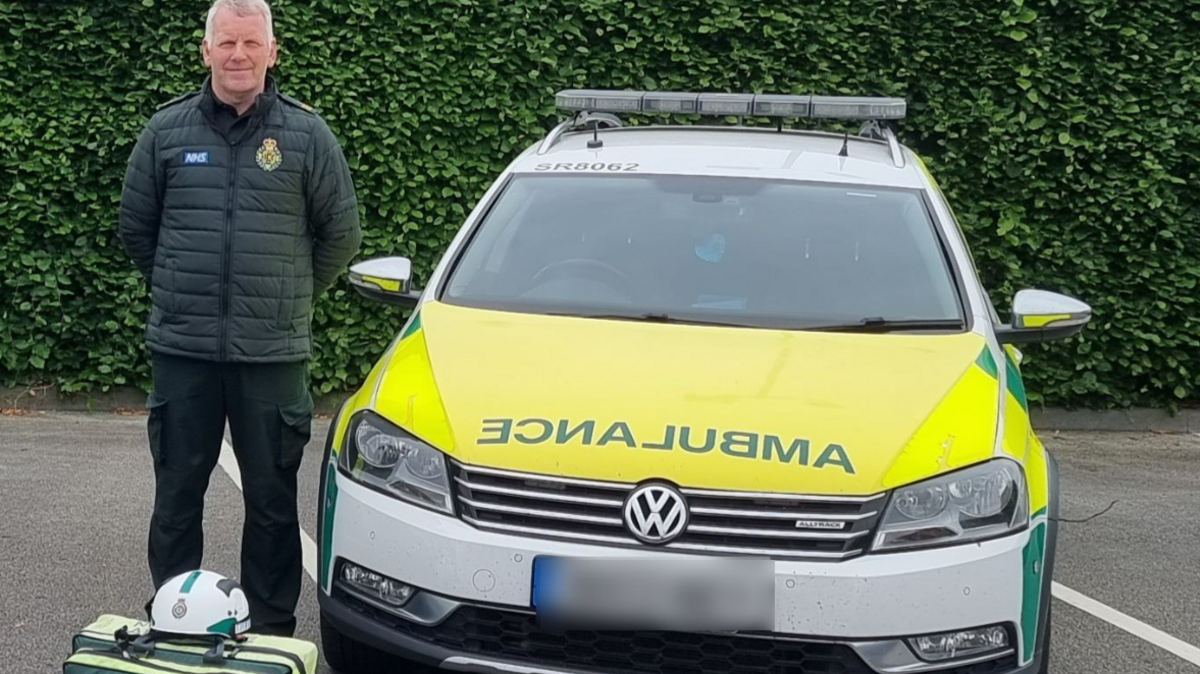Blue lights ban may put lives at risk - medic

Volunteer medic Gavin Palin has been with North West Ambulance Service for 23 years, but is now banned from using blue lights
- Published
A volunteer medic who has used his blue lights when responding to emergencies for 32 years claims a ban on him doing so could put lives at risk.
Gavin Palin claims he has faced intimidation from North West Ambulance Service (NWAS) after challenging the ruling over call-outs in Nantwich, Cheshire.
The North West Ambulance Service (NWAS) denied intimidation and said none of its volunteers should have blue lights because of “the risks connected with high-speed responses”.
Mr Palin faced an earlier ban in 2008 that prompted 1,000 people to march through Nantwich in protest and a petition was handed in to Downing Street by former MP Edward Timpson and Nantwich Town Council.
Two years later, NWAS reinstated his permission to use blue lights as an honorary member of staff.
Mr Palin said he had gone on to complete his Emergency Medical Technician (EMT) level 1 course, which the then service said would increase the range of incidents he could respond to.
But NWAS now say he had only become an "enhanced community first responder" not an EMT1, despite his badge identifying him as "Gavin Palin, EMT1, paramedic emergency service".

Mr Palin is no longer allowed to touch the control unit for his blue lights
Mr Palin said the service needed to “see sense”.
“It gets very frustrating when you’re going to a serious call and you know they haven’t got time,” he said.
The ban was put in place last November, but Mr Palin said he had decided to now make it public after facing “quite a lot of intimidation from the ambulance service since I’ve challenged them”.
Speaking about the impact of the ban, he said some patients who had later died “would have had a better chance of survival without a doubt” if he had been able to use his lights as “time is at the forefront”.

Mr Palin revived Matthew Anderson (middle) eight years ago when he had a cardiac arrest in a shop
Mr Palin highlighted how he had used the blue lights eight years ago to reach a shop in Nantwich and revive three-year-old Matthew Anderson after he went into cardiac arrest.
Matthew’s mother Rebecca Anderson said her son “definitely wouldn’t be here” without Mr Palin, who had arrived “minutes before the ambulance”.
“Traffic on a Saturday morning is gridlocked, so it’s very important that he was able to get the cars to move out of the way,” Ms Anderson said.
Matthew’s father James said the decision to stop Mr Palin using his emergency lights was “ridiculous”, adding: “They’re taking a needed service, which Gavin offers to Nantwich, away for no reason at all.”

Matthew and his family talking to Mr Palin
A letter from an NWAS official sent to Mr Palin outlining the decision stated he had not completed the relevant driving courses, which Mr Palin said was “not true”.
The official also claimed his vehicle was unsuitable under new legislation, because it was not big enough to convey sick, injured or disabled patients.
But a letter from ex-roads minister Guy Opperman, sent while he was in office, said vehicles used “for the purpose of providing a response to an emergency” can, in fact, be used under the legislation.
'Appreciate his passion'
Mr Palin said ambulances with staff crews would sometimes arrive 30 minutes after him, adding: “It depends on the demands on the service at the time.”
“I think they need to see sense and they should focus on the patients not the person who they’re trying to possibly intimidate,” he said.
An NWAS spokesperson said: “While we understand Mr Palin’s frustrations, we believe there are no grounds to justify a different position in relation to one individual.
“We greatly appreciate his passion and commitment to the ambulance service over the last 20 years and recognise the valuable contributions he makes.”
Get in touch
Tell us which stories we should cover in Staffordshire
Follow BBC Stoke & Staffordshire on BBC Sounds, Facebook, external, X, external and Instagram, external.
Related topics
- Published23 August 2024
